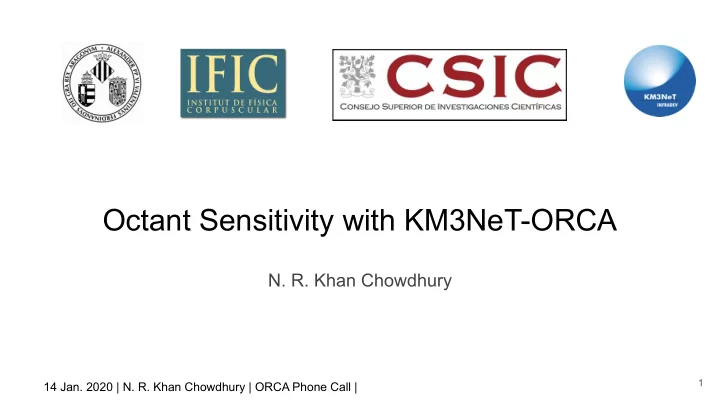

Octant Sensitivity with KM3NeT-ORCA N. R. Khan Chowdhury 1 14 Jan. 2020 | N. R. Khan Chowdhury | ORCA Phone Call |
What is octant degeneracy? The ambiguity in the determination of 𝜾 23 can be from two sources, 1) Inherent octant degeneracy: Oscillation and survival probabilities are function of sin 2 2 𝜾 23 . 2) Degeneracy of the octant with other oscillation parameters: oscillation and survival probabilities are function of sin 2 𝜾 23 or cos 2 𝜾 23 . Probabilities become identical for value of 𝜾 23 in opposite octant for different value of 𝜾 13 and 𝜺 CP . Conventions: Lower (Higher) Octant => LO (HO). Normal (Inverted) Ordering => NO (IO). 2
Octant ambiguity in the electron channels The relevant probabilities in the OMSD approximation with matter effects reads m reaches value ~ 1 irrespective of the value of 𝜾 13 in vacuum and the During matter resonance, sin2 𝜾 13 product is no longer invariant for opposite octants for different values of 𝜾 13 . The electron survival probability is independent of 𝜾 23 and does not contribute to octant sensitivity. 3
P 𝝂 e in light of non-zero 𝜾 13 Figure depicts the separation of LO and HO curves for three different true 𝜾 13 values. NO assumed. For 𝜾 23 in LO (= 42.8° in plots), lower values of true 𝜾 13 (left) is imperative to get higher sensitivity to the octant resolution since it is more separated from the wrong 𝜾 23 lines of variation of the probability over the whole range of test 𝜾 13 . As the true 𝜾 13 increases, the separation decreases. The reverse is true for 𝜾 23 in HO. 4
Octant ambiguity ensued in muon channels Leading terms (octant degenerate) sub-leading term lifting the degeneracy The strong octant sensitive behaviour of sin 4 𝜾 23 sin 2 2 𝜾 13 m near resonance can override the degeneracy since 𝜾 13 in matter gets amplified to maximal values. Since P e 𝝂 is the CP conjugate of P 𝝂 e , the probability level discussion is the same as P 𝝂 e for no CPV assumptions. 5
P 𝝂𝝂 in light of non-zero 𝜾 13 Figure depicts the separation of LO and HO curves for three different true 𝜾 13 values. NO assumed. The effect of 𝜾 13 on the separation between opposite 𝜾 23 lines is less, since it is governed by intrinsic octant degeneracy. Still, for 𝜾 23 in LO (= 42.8° in plots) higher values of 𝜾 13 (right) can give a higher octant sensitivity since it is more separated from the wrong 𝜾 23 lines varied over entire range of 𝜾 13 . The reverse is true for 𝜾 23 in HO. 6
Asymmetry in P 𝝂𝝂 and P 𝝂 e channels Normal Ordering (NO), 𝜾 13 = 8.54° (NuFit3.2) 7
Octant Sensitivity: True NO, Ordering Marginalised In both cases, the min chisq is never reached in the wrong hierarchy. This confirms, NMO is not an issue in the octant determination at ORCA. The 𝛙 2 is lower for true HO in general. 𝛙 2 = (N LO(HO) - N HO(LO) ) 2 / N HO(LO) for true HO (LO). Although the numerator remains the same, the denominator is larger for true HO resulting in lower sensitivity. 8 T2K (4+4) + NO 𝝃 A (3+3) curves for comparison. https://arxiv.org/abs/1902.02963
Octant Sensitivity: True IO, Ordering marginalised In both cases, the min chisq is never reached in the wrong hierarchy. This confirms, NMO is not an issue in the octant determination at ORCA. Assuming Inverted Ordering gives worse results, since matter resonance and hence octant sensitivity comes from the anti-neutrino channel for which flux and cross-sections are lower. 9 T2K (4+4) + NO 𝝃 A (3+3) curves for comparison. https://arxiv.org/abs/1902.02963
Octant Sensitivity (for range of 𝜾 23 values): A 3 𝛕 sensitivity is obtained for 41.5° > 𝜾 23 > 49° if NO is the true ordering (left). T2K (3 years neutrino mode) + NO 𝝃 A (3+3) lines for comparison. https://arxiv.org/abs/1302.1370 10
Summary : 1) Preliminary estimation of octant sensitivity projection with 3 years of ORCA115 has been presented. 2) Neutrino mass ordering is not a source of ambiguity in the octant determination at ORCA. 3) Study octant sensitivity in the presence of new physics will involve further degeneracies apart from the standard 8 fold ordering - octant - CP violating phase factor degeneracy. 11
THANKS 12
Recommend
More recommend